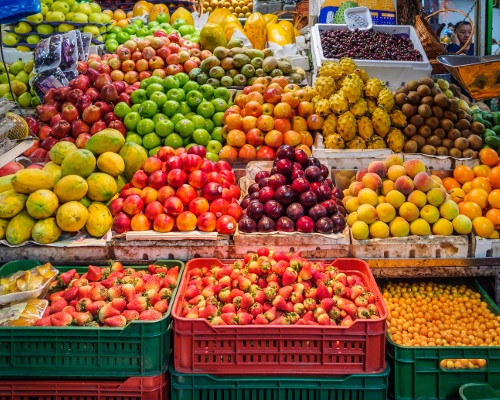How To Navigate Peak Fruit & Produce Season

Navigating peak fruit and produce season can make or break your success in the market as a produce business. Understanding the seasonality of fruits and vegetables and how to maneuver through fluctuations can significantly impact profitability.
After all, the ebb and flow of seasonality dictates the availability, quality, and pricing of fruits and vegetables. This cyclical nature creates distinct peaks and troughs throughout the year.
These fluctuations are not just about the weather —they're also influenced by various farming practices and specific trends seen across geographical regions. As a result, the produce commodity market is constantly influx, thus only the companies skilled at adjusting to constant change have been destined to succeed.
Here’s what you need to know.
Challenges of peak season
Peak seasons in the food industry, whether it’s during the winter, summer, or spring, bring both opportunities and challenges for those involved in the supply chain. Here are the key challenges that businesses often find themselves grappling with.
Meeting spikes in demand
One of the major hurdles faced during these peaks is managing sudden spikes in demand.
Imagine, for example, the surge in orders for strawberries as soon as spring kicks in. Meeting this sudden increase while maintaining quality can be a real challenge. Growing regions often face constraints due to weather fluctuations, affecting crop yield and quality. For instance, an unanticipated frost during the spring can devastate certain crops, disrupting expectations and seasonal prices.
Market volatility
Market volatility adds to the complexity. Prices of produce can fluctuate dramatically during peak seasons, impacting profit margins for distributors and growers.
The United States Department of Agriculture (USDA) frequently updates reports on crop conditions, providing crucial insights into the market. However, rapid shifts in demand due to changing consumer preferences or unexpected news can lead to sudden market imbalances.
This unpredictability often poses challenges for accurately forecasting supply and demand, which is crucial for maintaining balanced and profitable operations during peak times.
Logistics and transportation
The transportation of perishable produce and general logistics of the supply chain pose additional challenges. When the market shifts, efficient transportation and storage solutions are essential to meeting the surge in demand. However, logistics networks often face bottlenecks due to the sudden surge, leading to delays in shipments and the potential spoilage of perishable items.
Finding the right balance between supply, demand, and transportation logistics becomes a delicate dance during these peak times.
Tips for navigating peak season
Navigating through the bustling peak season requires a blend of strategic planning and leveraging technology. Here are some key tips.
Understand ripening and harvest patterns
To start, understanding the ripening and harvest patterns of different produce is crucial. Each fruit or vegetable, from apples to winter squash, follows a unique growth cycle.
For instance, knowing when a pea or a leaf vegetable reaches its peak sweetness or when a sweet potato is ready for harvest ensures buyers know the optimal time to secure different products. Utilizing this knowledge helps in planning sales, aligning them with market demands to maximize profitability.
Enlist the help of technology
Technology can play a significant role in streamlining operations during peak season.
Advanced software solutions can give you access to charts and data analytics, which aid in forecasting demand patterns based on historical data and market trends. This allows growers and distributors to anticipate fluctuations and adjust supply accordingly.
Moreover, employing sensors and monitoring systems in storage facilities can help maintain optimal conditions for different cultivars, preserving their color, flavor, and shelf life.
Practice diversification
Another valuable strategy is diversification. Rather than focusing solely on a single product, businesses can deal with a variety of produce with staggered harvest times. This approach minimizes the risk associated with relying on one individual product's success or failure during peak seasons.
Market your products
Marketing becomes equally crucial during these times. Highlighting the uniqueness of each fruit or vegetable helps to capture consumer interest and allows businesses to see an improvement in sales numbers in between peak seasons.
Emphasizing the freshness and quality of produce in marketing campaigns can set a distributor apart in a crowded market.
How Silo helps with peak season challenges
Properly navigating peak season means making use of the right solutions for your businesses goals. For that, consider Silo’s fintech offerings — a suite of business solutions that have been developed for the produce industry, by the produce industry, and are tailored to its unique set of needs.
Silo’s Enterprise Resource Planning (ERP) solution connects all aspects of your business – inventory, orders, accounting, and insights reporting – to enhance visibility into operations and increase efficiencies where it matters most for your bottom line. Silo’s platform makes running your business easy during periods of high-demand so that you can continue to concentrate on high level strategy and your long term goals.
If you’re looking to break into new markets, consider leveraging Silo’s capital program to help you meet your goals. Silo Cash Advance, one of their most popular offerings, gives you the funds necessary to diversify your product lines, and its easy access makes Silo’s solution ideal for small and medium-sized businesses who may normally have trouble accessing fast financing in a pinch.
Silo Instant Pay, meanwhile, helps suppliers bridge costly customer payment gaps, providing up to 90% of the invoice amount in only 3 days. This keeps business moving and cash flowing so you business leaders and properly capitalize during the season when mobility is most crucial.
Learn more about how Silo can help you secure the working capital today.
Want to book a demo with us?
Add your info and we’ll get one scheduled with you.